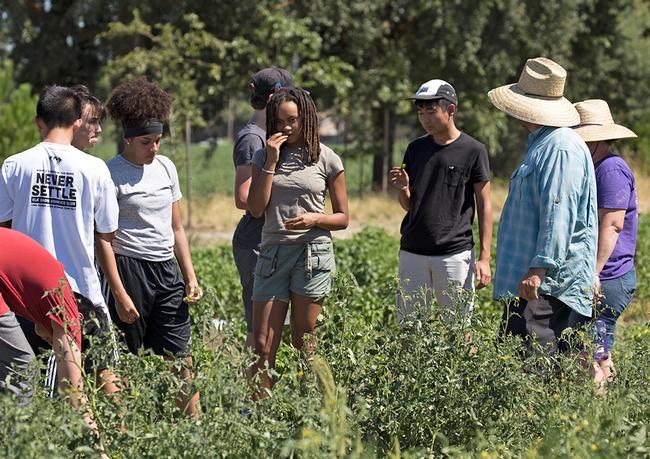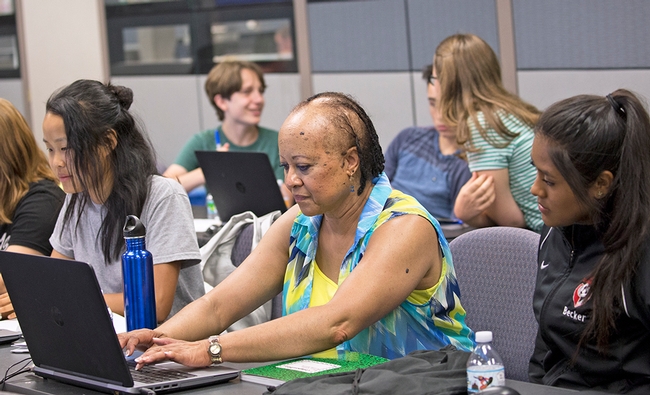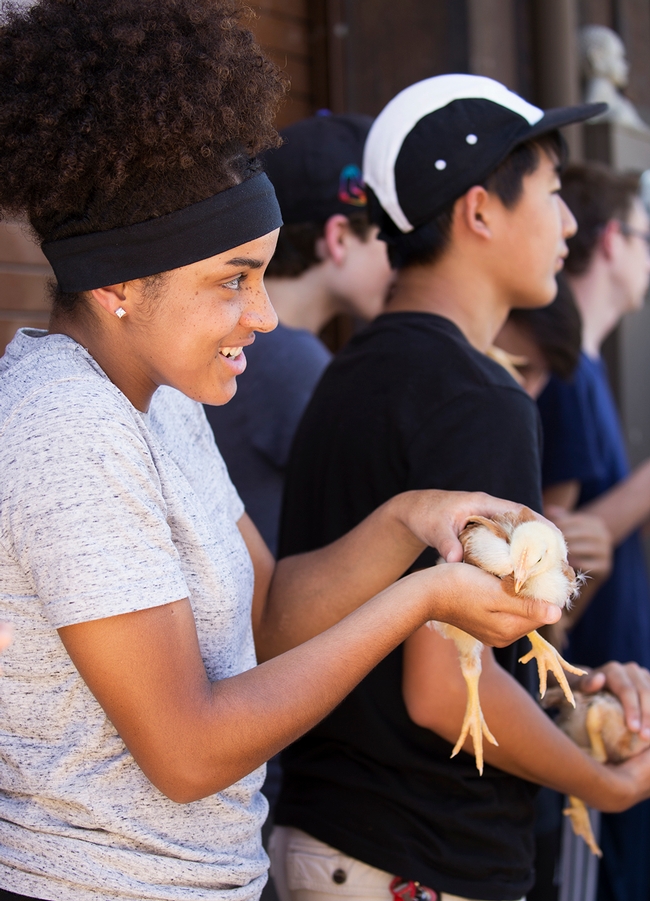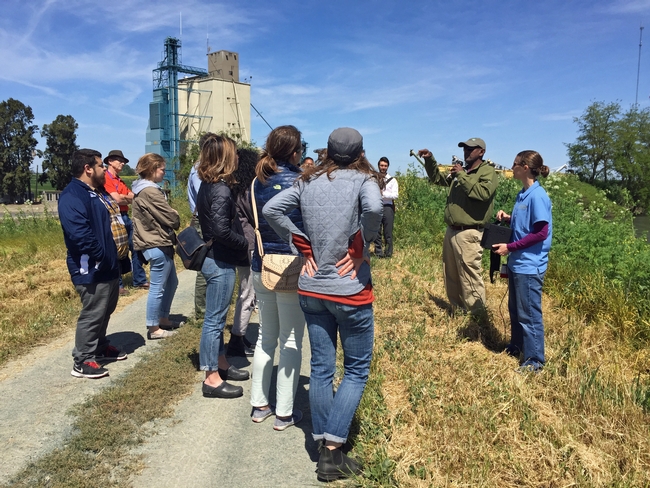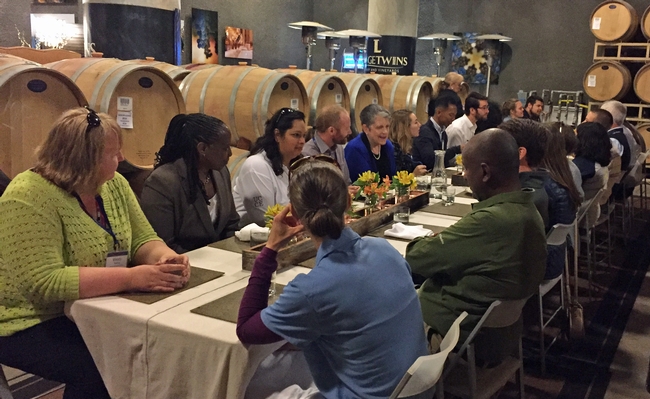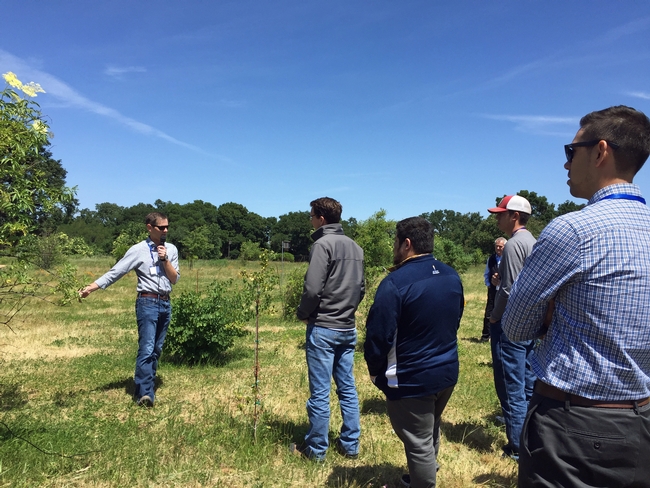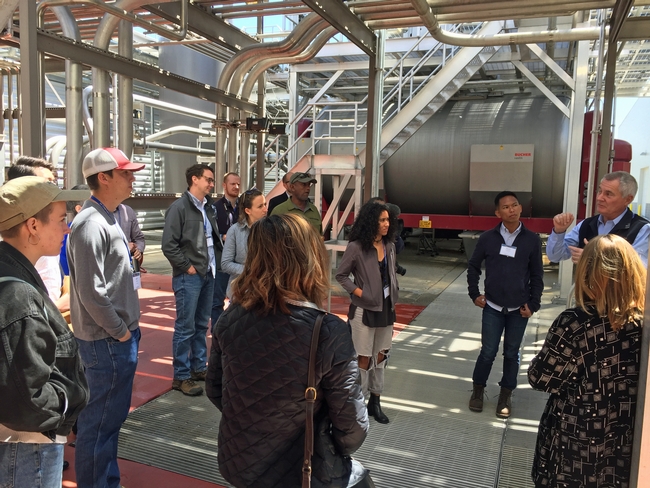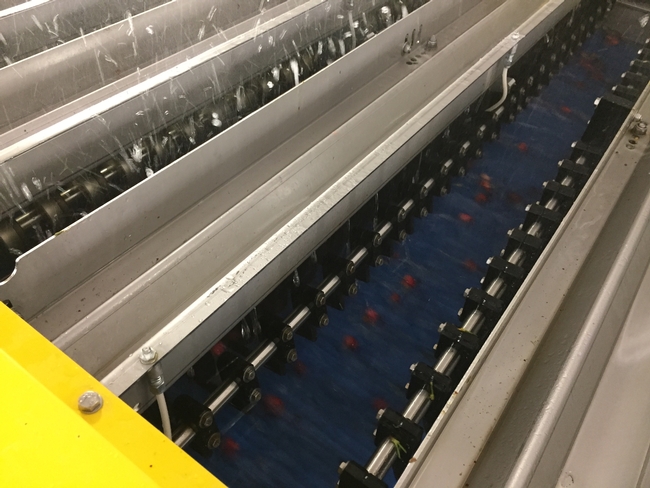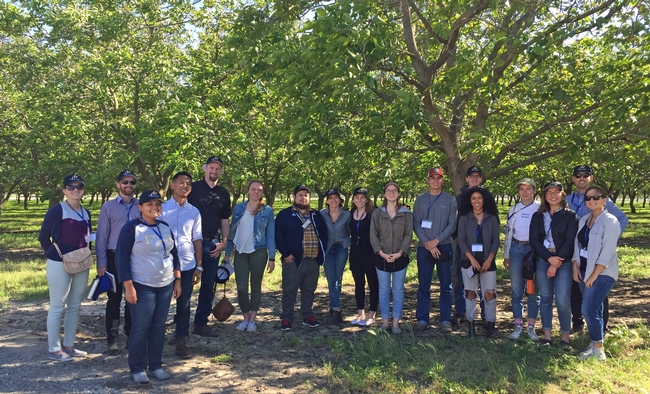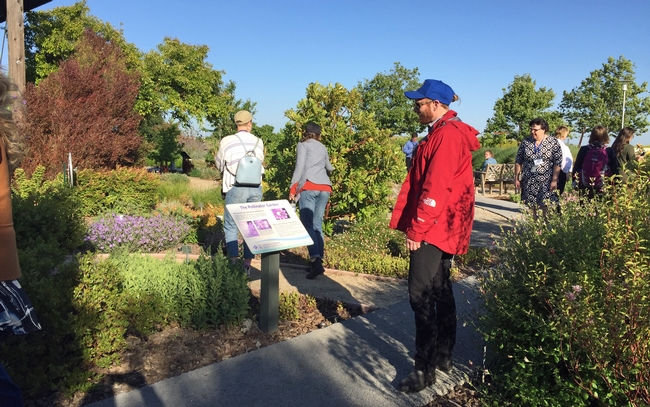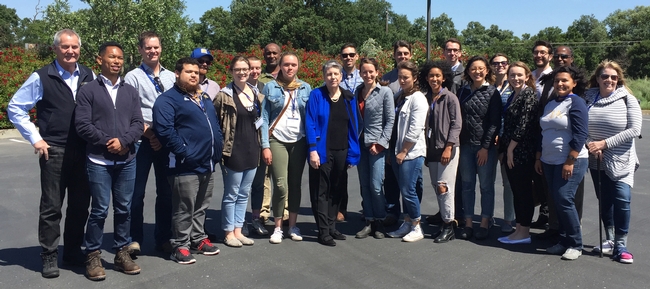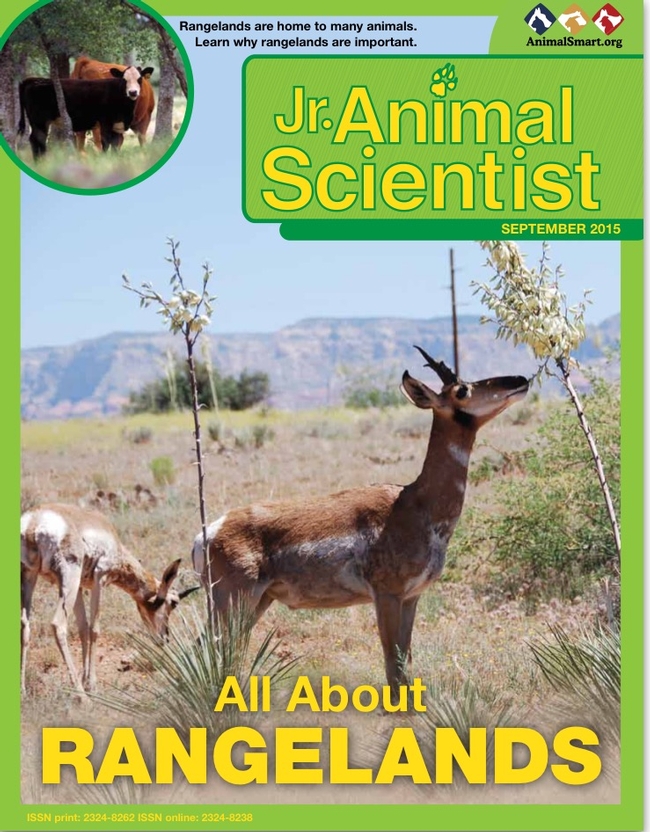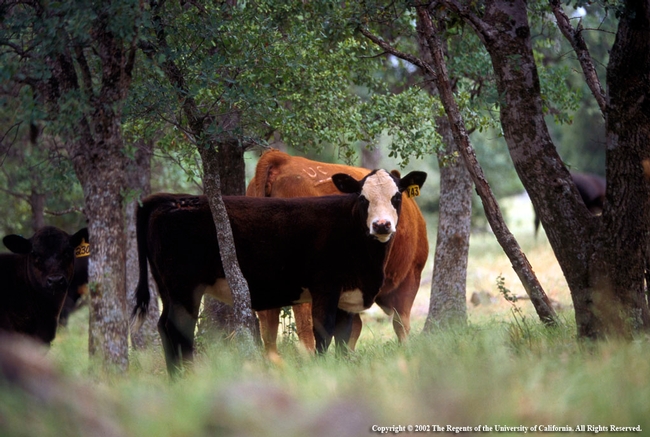Posts Tagged: literacy
STEAM summer camp introduces teens to ag tech
As part of her job with the USDA, Joyce Hunter often attended meetings focused on using open data from the government to solve problems related to food and agriculture. But she noticed a distinct lack of women and young people at those open data meetings. Hunter was told there just weren't many who were interested.
“I thought to myself, well, they aren't looking in the right places,” said Hunter, an African American woman and former chief information officer at USDA. “Maybe we ought to encourage youth of different cultures and colors in order to ensure the pipeline is filled for the future. So I went to my CIO and asked her if it would be okay to set up an open data camp for youth, particularly underserved youth.”
By partnering with The Governance Lab at New York University and other agencies, Hunter organized summer camps for youth to experience science, technology, engineering, agriculture and math, or STEAM. This summer, she brought the STEAM camp concept to Sacramento. For two weeks in July, about two dozen high-school students went on field trips and engaged in STEAM-based activities as part of the California Open Data STEAM Summer Camp.
“One of the things I love about it is the kids are so curious and they're coming up with their own research questions, with their own challenges,” said Melanie Weir, a STEAM camp instructor. “They're asking questions about why agriculture is important to them. Why food is important to them.”
Adam Low, a sophomore at Franklin High School in Elk Grove, was one of the camp participants.
“I chose the water and drought group because as a Californian, we know California was most recently in a drought. And I wanted to see what this data camp could teach me about water and how it affects agriculture and other topics,” said Low.
“They're traveling all over,” Weir said. “They went to different places. They went to Russell Ranch, they saw the drones, they're really excited about it. They saw the UC Davis laboratory and the UC ANR researchers. They saw helicopters. They saw these big machines that have 35 cameras that do 3-D dimensional pictures of crops and what's out there. They also went to the Cannery and they loved hugging the chickens. They thought it was the greatest thing in the world.”
The California Open Data STEAM Summer Camp was made possible through a partnership between USDA, The Governance Lab and UC Agriculture and Natural Resources.
Delta farm tour gives UC students a broader view of food system
UC Global Food Initiative student fellows from University of California campuses throughout the state gathered for a springtime field trip in the Central Valley to learn more about the relationships between food, farming and the environment.
The day-long tour, hosted by UC Agriculture and Natural Resources, began at a farm that is maintained to support wildlife in the breezy Sacramento-San Joaquin River delta region. The GFI fellows also viewed a habitat restoration project at LangeTwins Winery then watched freshly harvested cherries being processed at Morada Produce's packing plant. They wrapped up the day with a tour of a demonstration garden and a discussion of nutrition education at the UC Cooperative Extension office in Stockton.
UC President Janet Napolitano, who, along with UC's 10 chancellors, launched the Global Food Initiative in 2014, met with the 17 fellows for lunch at LangeTwins Winery.
“We started the Global Food Initiative several years ago with the goal of creating a pathway to a sustainable, nutritious food future for the planet. A small, modest goal,” Napolitano said, adding that she is excited to learn about the fellows' projects.
The GFI fellows are working on projects that range from raising awareness about food production to analyzing the effects of climate change on pollination, and from efforts to make soils safe for growing food in urban areas to using food waste to fuel batteries.
UC Merced senior Ever Serna's GFI project is to educate his fellow college students about where food comes from, before it gets to the grocery store.
“The tour gave me a deeper understanding and appreciation about how food is developed and grown,” he said. “I think when I eat vegetables and fruits, I'm going to be more conscious of what I eat now.”
Reid Johnsen, a third-year Ph.D. student in agricultural and resource economics at UC Berkeley, Global Food Initiative fellow for UC ANR, and participant in the Graduate Students in Extension program, is working with UC Cooperative Extension in Sonoma County to study ranchers' preferences for different payment structures for conservation easement to compensate them for the ecosystem services provided by their land.
“To be able to see agriculture in action makes such a difference to me, to see the way the crops are produced and the variety that's out here,” said Johnsen. “The diversity of crops was not something I was aware of before coming on this trip.”
“I thought it was interesting to see a lot of different agricultural production systems,” said UC Santa Barbara senior and campus GFI ambassador Bryn Daniel, who works with student activists on student food access and housing security issues.
In addition to learning more about food production, the outing gave the fellows an opportunity to network with peers from other campuses.
“That's what I liked about today's meeting, just meeting everybody and getting these fantastic connections,” said Ryan Dowdy, a third-year Ph.D. student at UC Davis who is converting food waste into energy-producing microbial fuel cells.
“I think this program, and especially the fellowship, is really important for young scientists who dive into this really huge subject of global food,” said Claudia Avila, a graduate student at UC Riverside who studies trace metals in urban agricultural soils.
Best kept secret
In welcoming the UC GFI fellows, Glenda Humiston, UC vice president for agriculture and natural resources, said, “I have a feeling a lot of you aren't familiar with our division. As I travel around the state to different campuses, I keep being told that we're the best kept secret, which I personally do not think is a good thing."
She explained that agricultural research has been part of the University of California since the land-grant institution's beginning in 1868 in Oakland. UC ANR has researchers on the Berkeley, Davis and Riverside campuses and UC Cooperative Extension advisors in the county offices, she said, adding, “Here in California, our advisors have very robust research programs.”
Farms are wildlife habitat
Michelle Leinfelder-Miles, UC Cooperative Extension delta crops advisor, introduced Dawit Zeleke, associate director of conservation farms and ranches for The Nature Conservancy, who explained why he farms 9,200 acres of corn, triticale, potatoes, alfalfa and irrigated pasture to enhance foraging habitat for sandhill cranes and other wildlife on Staten Island. The Nature Conservancy partners with UC Cooperative Extension along with the U.S. Fish and Wildlife Service, the U.S. Geological Survey, California Department of Water Resources, Oregon State University, UC Merced and UC Davis to study the relationships between agriculture and natural resources.
The Pacific Flyway for migrating birds passes over the delta. “Eighty percent of waterfowl depend on agriculture for food,” Zeleke said. After wheat harvest, they flood the fields. “You should see it in September, October, November and December. Thousands of birds, ten thousand cranes use this place for habitat.”
Lodi region is zin-ful
En route to lunch, Paul Verdegaal, UC Cooperative Extension viticulture advisor for San Joaquin County, described the Lodi region's wine industry. There are about 750 growers, many of which are small family operations. While 10 to 15 acres used to be typical vineyard size, most have 100 acres to be sustainable and one family member works at an outside job.
“Agriculture is a tough job and there is no guaranteed income,” Verdegaal said.
About 40 percent of the zinfandel in California is grown in the Lodi region, but there are several wine grape varieties planted.
Pointing out the bus window to a vineyard interplanted with a crimson clover cover crop, Verdegaal said, “We do see interest in using as few chemicals as possible and using techniques of the integrated pest management program.”
After eating lunch at LangeTwins Winery in Acampo, the GFI fellows took a tour of the winery with the fourth- and fifth-generation owners, Randy Lange and Aaron Lange. The Langes are founding members of the Lodi Rules Program, which helps growers produce grapes and wines in a manner that is environmentally respectful, socially sensitive and economically sound. They pointed out an array of solar panels covering the grape press room that provide electricity. The Langes are planting native plants around the winery to reduce sedimentation, improve water quality and restore wildlife habitat along the Mokelumne River.
Bing is king of cherries
When the GFI fellows visited at the end of April, sweet cherry harvest had just begun in Bakersfield area orchards, and cherries were being packed and shipped in San Joaquin County.
“Hemmed in by rain to the north and heat to the south, cherry season is only eight to 10 weeks long,” said Joe Grant, emeritus UC Cooperative Extension farm advisor for San Joaquin County.
“While the Bing variety is still the mainstay of the California cherry industry because of its excellent eating and shipping quality,” said Grant, “acreage of other high quality and earlier-maturing varieties has increased in recent years to lengthen the harvest season. But Bing is still king.” Asked about the effects of climate change on cherries, Grant explained that warmer temperatures are reducing the number of winter chilling hours, which cherries need.
The fellows saw the hand-picked fruit being processed for packing at Morada Produce, a family farm in Linden that also grows walnuts, peppers and onions.
“Keeping produce cold is key to maintaining quality,” said Scott Brown, Morada's production manager, as the fellows watched fresh, cold water rain down onto the freshly picked sweet cherries. The leaves and stems floating to the top were removed as the red clusters glided in the water to the cluster cutter, which gently separated the clusters into individual cherries. Gently conveyed through the plant in flowing water, the cherries were sorted by size and quality at the highly mechanized facility. Air ejectors spit out rejected fruit, so only 70 percent makes it into a packed box.
“Fruit picked on Monday is packed Tuesday, then shipped to Korea, Japan, Australia and other export markets to be eaten by Friday,” Brown said.
The fellows were fascinated to see the steps taken to ensure high-quality cherries are cooled, sorted and packaged for shipping to stores and consumers.
“It was just so much more complicated than I knew,” said Jess Gambel, a third-year Ph.D. student at UC San Diego who is studying the effects of climate change on bee pollination in squash plants.
Sustainable gardening
The tour wrapped up at the UC Cooperative Extension office in Stockton, with a discussion about how UC CalFresh and the Expanded Food and Nutrition Education Program help low-income Californians attain adequate nutrition and food security, followed by a tour of the demonstration garden maintained by the UC Master Gardener Program volunteers.
“There are more pollutants in urban runoff than in ag runoff,” said Karrie Reid, UC Cooperative Extension landscape horticulture advisor in San Joaquin County. Reid described how she and the UC Master Gardeners work with home and community gardeners to reduce pesticide and water use, and noted that a Water Use Classification of Landscape Species plant list, based on UC research, is available to help gardeners choose landscape plants.
“As a soil scientist, I really appreciated the recurring emphasis on soils as the foundation for agriculture,” said a fourth-year Ph.D. student at UC Berkeley and GFI fellow with Lawrence Berkeley National Laboratory. “From talking with The Nature Conservancy farm operator about how they were conserving carbon in those soils and doing wetlands management to hearing about special properties of the sandy loam soil in this part of the county, and talking with the Master Gardener folks about soil contamination issues.”
This is the third class of GFI student fellows. The undergraduate and graduate student fellows, representing all 10 UC campuses plus UC Agriculture and Natural Resources and Lawrence Berkeley National Laboratory, have helped further UC's Global Food Initiative efforts to sustainably and nutritiously feed the world's growing population by working on food-related projects and raising awareness of this critical issue.
Children’s magazine focuses on rangeland animals
Rangeland is where deer and antelope play. It is also home for grazing livestock and many other animals. “Almost half of the land on Earth is rangeland and one-third of the United States is rangeland,” the latest issue of Jr. Animal Scientist tells its young readers. A UC Agriculture and Natural Resources (UC ANR) advisor is among the scientists who contributed to the rangeland issue of the children's magazine.
Jr. Animal Scientist is published by the American Society of Animal Science for children aged 5 to 12 who are interested in animals. For the September 2015 issue, members of the Society for Range Management collaborated with ASAS to provide photos and facts about rangeland.
Theresa Becchetti, UC ANR Cooperative Extension livestock and natural resource advisor for Stanislaus and San Joaquin counties, and Lisa Page, from the University of Arizona, served as co-editors for the special issue.
“Our goal is to have kids and their parents and teachers learn the value of rangelands, beyond being used to produce beef and lamb; they also provide habitat for wildlife,” said Becchetti. “Rangelands can produce energy – solar, wind and oil – while providing clean water and air and a place for recreation. These resources are protected by ranching families, the stewards who make their homes on rangeland.”
In the magazine, readers will find descriptions of the different kinds of rangeland, a map of rangelands and photos of some wildlife species that live on rangelands. It also includes a word scramble and rangeland-related jokes (“Why do cows wear bells? Because their horns don't work!”)
“As a member of the Society for Range Management, and working on developing curriculum on rangelands in California, I was excited to be involved in the effort,” Becchetti said. “The magazine has a national circulation with a mix of families and schools.”
A PDF of the Jr. Animal Scientist rangeland issue can be viewed at http://ucanr.edu/sites/news/files/220859.pdf.
Children learn about food and farming at annual AgriBee
UC Cooperative Extension nutrition advisors in Butte, Colusa, Glenn, Tehama and Yuba/Sutter counties teamed up with local farm bureau offices to present the 6th annual AgriBee, a spelling bee for third- and fourth-graders with words limited to agricultural terms.
The children are required to spell and define the words, said an article about the competition in the Chico Enterprise-Record.
Here are some examples from the word list that I thought might stump an 8- or 9-year-old:
Abomasum - the fourth or true stomach of a ruminant
Catkin - a dense spike of small, petalless flowers
Roughage - feeds that are made of grass, hay or silage
Vegetate - grow or sprout like a plant
Wether - a castrated male sheep
Each student competed in a school-wide competition to earn a place in the regional AgriBee. The winner was Kirsten-Grace Baker of the Children's Community Charter School in Paradise. She won a laptop computer by correctly spelling and defining "pullet," a chicken that has never laid an egg.
The AgriBee was designed to boost students' understanding and knowledge of food and agriculture.
LA 4-H coordinator appointed to state board
Dawn Fuller, 4-H program coordinator for UC Cooperative Extension in LA County, has been appointed by the governor's office to the School's Agriculture and Nutrition Program (SANP) in the San Gabriel Valley, according to an article in the Whittier Daily News.
SANP is offered by the 48th District Agricultural Association, one of 78 fair districts in the state. Each district's mandate is to put on a fair, but in the 48th District, it became increasingly difficult with urbanization and the loss of the fairgrounds. The 48th District board created SANP to increase the understanding, appreciation and participation of urban teachers and students in agriculture and nutrition.
According to the SANP website, staff members work with teachers throughout the year to make it easier for them to teach agriculture in their classrooms. They provide teachers with ag-related project kits for conducting hands-on activities, such as vermiculture, hatching chicks or trout, gardening and hydroponics.
The materials are provided free of charge in exchange for exhibits that demonstrate what students have learned. The exhibits are components of the District's annual spring fair.
The article about Fuller's appointment to the board also appeared in the Pasadena Star-News.

